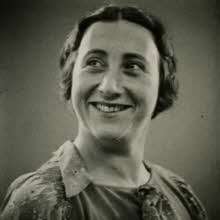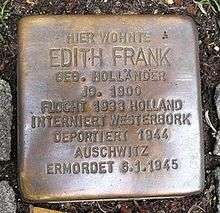Edith Frank
Edith Frank (née Holländer; 16 January 1900 – 6 January 1945)[1] was the mother of Holocaust diarist Anne Frank, and her older sister Margot. She was a prisoner during the Holocaust at Auschwitz-Birkenau concentration camp, where she died from starvation.
Edith Frank | |
|---|---|
 | |
| Born | Edith Holländer 16 January 1900 |
| Died | 6 January 1945 (aged 44) |
| Cause of death | Starvation |
| Nationality | German |
| Other names | Abel |
| Known for | Mother of Anne and Margot Frank |
| Home town | Aachen, Germany |
| Spouse(s) | |
| Children | Margot Frank Anne Frank |
Biography
Early life
Edith was the youngest of four children, having been born into a German Jewish family in Aachen, Germany. Her father, Abraham Holländer (1860–1928) was a successful businessman in industrial equipment who was prominent in the Aachen Jewish community together with Edith's mother, Rosa Stern (1866–1942). The ancestors of the Holländer family lived in Amsterdam at the start of the 18th century, emigrating from the Netherlands to Germany around 1800. Edith's last name, Holländer, is German for "Dutchman" (literally: "Hollander").[2][3] Edith had two older brothers, Julius and Walter, and an older sister, Bettina. Bettina died at the age of 16 due to appendicitis when Edith was just 14. Both Julius and Walter made it to the United States, surviving afterwards. The Holländer family adhered to Jewish dietary laws and was considered to be religious. Nevertheless, Edith attended the Evangelical Higher Girls’ School and passed her school-leaving exams (Abitur) in 1916. Afterwards, she worked for the family company. In her free time, she read copiously, played tennis, went swimming and had a large circle of friends.
Family
She met Otto Frank in 1924 and they married on his 36th birthday, 12 May 1925, at Aachen's synagogue. They had two daughters born in Frankfurt, Margot, born 16 February 1926, followed by Anne, born 12 June 1929.
Immigration
The rise of antisemitism and the introduction of discriminatory laws in Germany forced the family to emigrate to Amsterdam in 1933, where Otto established a branch of his spice and pectin distribution company. Edith found emigration to the Netherlands difficult. The family lived in confined conditions and she struggled with the new language. She remained in contact with her family and friends in Germany, but also made new friends in Amsterdam, most of them fellow German refugees. Edith was an open-minded woman who educated her daughters in a modern way. Her older brothers Walter (1897–1968) and Julius (1894–1967) escaped to the United States after 1938, and Rosa Holländer-Stern left Aachen in 1939 to join the Frank family in Amsterdam, where she died in January 1942.
Anne Frank's cousin Bernhard ("Buddy") Elias has said that "Edith never felt well in Holland. Edith was German, and she missed Germany. She did not learn Dutch very well. She did not feel at home in Amsterdam."[4]
Persecution and death

In 1940, the Nazis invaded the Netherlands and began their persecution of the country's Jews. Edith's children were removed from their schools, and her husband had to turn over his business to his Dutch colleagues Johannes Kleiman and Victor Kugler, who helped the family when they went into hiding at the company premises in 1942.
The two-year period the Frank family spent in hiding with four other people (their neighbours Hermann van Pels, his wife Auguste Van Pels and his son Peter Van Pels, and Miep Gies's dentist Fritz Pfeffer) was famously chronicled in Anne Frank's posthumously published diary. In her diary, the adolescent Anne frequently writes about the disagreements, conflicts, mutual lack of understanding, and the pessimism of her mother, which she wants to disassociate herself from. However, she repeatedly also describes her mother as an understanding and loyal woman who stands up for her daughters and protects them against verbal attacks from the other inhabitants. The diary ended three days before they were anonymously betrayed and arrested on 4 August 1944. After detainment in the Gestapo headquarters on the Euterpestraat and three days in prison on the Amstelveenweg, Edith and those with whom she had been in hiding were transported to the Westerbork concentration camp. From there, they were deported to Auschwitz concentration camp on 3 September 1944, on the last train to be dispatched from Westerbork to Auschwitz.
Edith and her daughters were separated from Otto upon arrival, and they never saw him again. Edith looked for ways of keeping her children alive. Survivors later described them as an inseparable trio. On 30 October, another selection separated Edith from Anne and Margot. Edith was selected for the gas chambers, and her daughters were transported to Bergen-Belsen. Edith escaped with a friend to another section of the camp, where she remained through the winter. While here she hid every scrap of food she got and saved it for her daughters. Because she refused to eat any of the food she was saving for her daughters, she died from starvation on 6 January 1945, three weeks before the Red Army liberated the camp and 10 days before her 45th birthday. Her daughters outlived her by one month.[5]
Her daughter's diary
When Otto Frank decided to edit his daughter's diary for publication, he was sure that his wife had come in for particular criticism because of her often difficult relationship with Anne, and he deleted some of the more heated comments out of respect for his wife and other residents of the Secret Annex. Nevertheless, Anne's portrait of an unsympathetic and sarcastic mother was duplicated in the dramatizations of the book. Anne's portrayal of her mother was countered by the memories of those who had known her as a modest, distant woman who tried to treat her adolescent children as her equals.
In 1999, the discovery of previously unknown pages excised by Otto showed that Anne had discerned that, although Edith very much loved Otto, Otto — though very devoted to Edith — was not in love with her; and that this understanding was leading Anne to develop a new sense of empathy for her mother's situation. By the time Edith and her daughters were in Auschwitz, Bloeme Evers-Emden, an Auschwitz survivor interviewed by Willy Lindwer in The Last Seven Months of Anne Frank (page 129), observed that "they were always together, mother and daughters. It is certain that they gave each other a great deal of support. All the things a teenager might think of her mother were no longer of any significance."
After their arrest and transfer to camp Westerbork the relationship between Anne and her mother improved as can be seen from a letter sent by Otto Frank to his cousin Milly on 16 November 1945:
It does not grieve me what she writes (about her mother) and I know quite well that there are several things she did not see and she would have changed her ideas. In fact she was on very good terms with her mother at the camp (Westerbork) later.[6]
Further reading
- The Diary of Anne Frank: The Revised Critical Edition, Anne Frank, edited by David Barnouw and Gerrold Van der Stroom, translated by Arnold J. Pomerans, compiled by H. J. J. Hardy, second edition, Doubleday, 2003.
- Anne Frank: The Untold Story. The hidden truth about Elli Vossen, the youngest helper of the Secret Annex, Jeroen De Bruyn and Joop van Wijk, Bep Voskuijl Producties, 2018.
- Anne Frank Remembered, Miep Gies with Alison Leslie Gold, Simon and Schuster, 1988.
- Roses from the Earth: the Biography of Anne Frank, Carol Ann Lee, Penguin, 1999.
- Anne Frank: the Biography, Melissa Muller, afterword by Miep Gies, Bloomsbury 1999.
- The Footsteps of Anne Frank, Ernst Schnabel, Pan, 1988.
- The Hidden Life of Otto Frank, Carol Ann Lee, Penguin, 2002.
- The Last Seven Months of Anne Frank, Willy Lindwer, Pantheon, 1991.
References
- "Edith Frank". 2010-07-06. Archived from the original on 2010-07-06. Retrieved 2017-10-18.CS1 maint: BOT: original-url status unknown (link)
- Edith Frank-Holländer, Anne's mother, Anne Frank House
- Pressler, Mirjam (2011). Treasures from the attic : the extraordinary story of Anne Frank's family. New York: Doubleday. p. 115-116. ISBN 038553387X.
- Diary of Anne Frank – Interview with Buddy Elias on YouTube. IMG Entertainment. Originally broadcast on BBC in 1996.
- Prose, Francine (2010). Anne Frank: The Book, the Life, the Afterlife. HarperCollins. p. 56. ISBN 978-0-06-143080-0.
- The Hidden Life of Otto Frank, Page 203